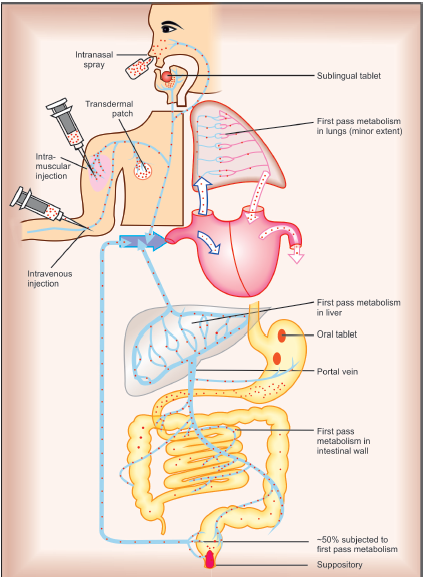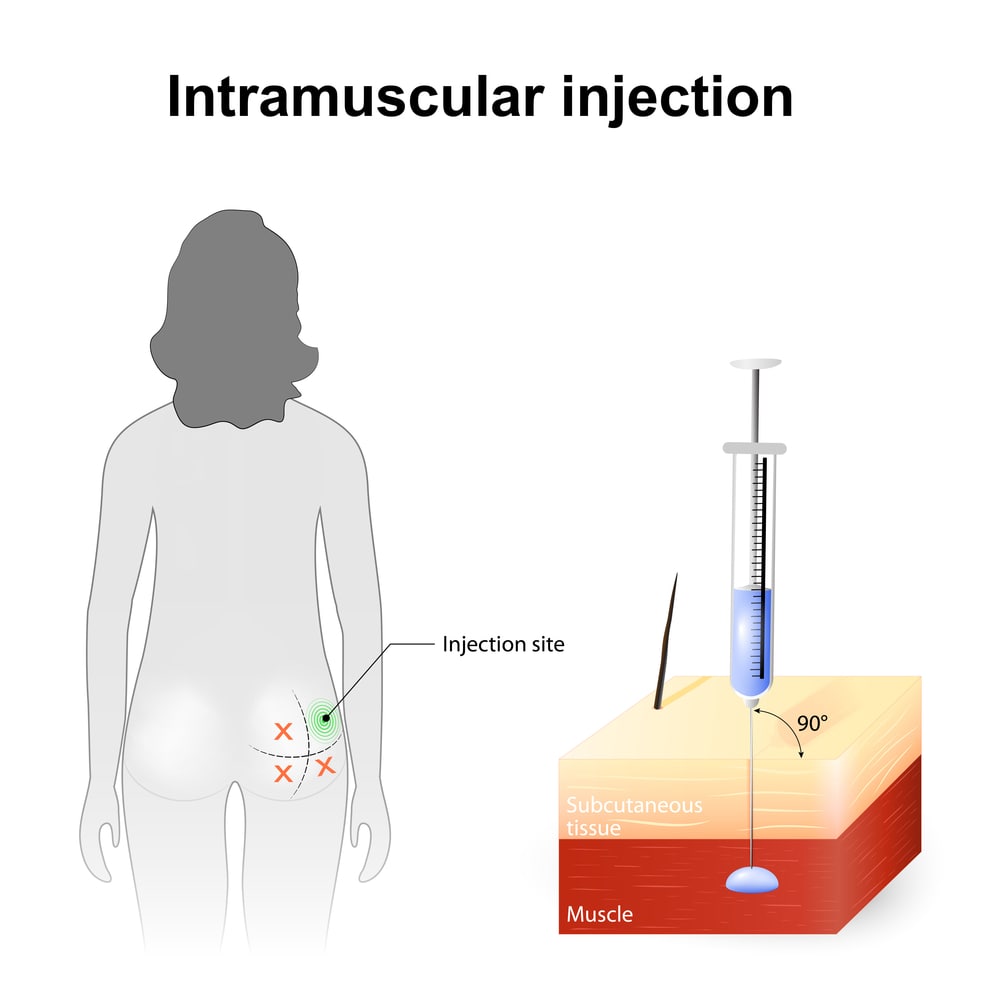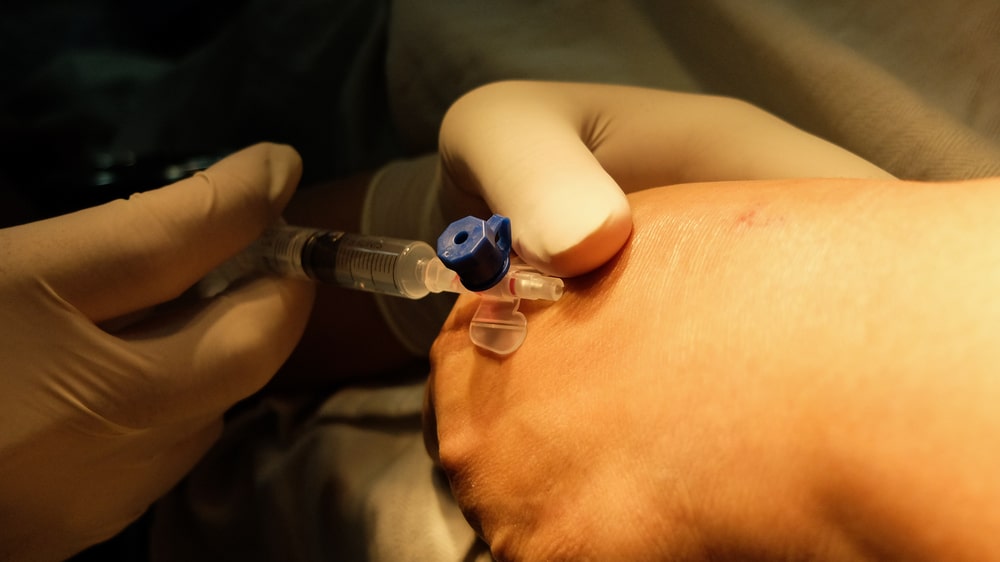Routes of drug administration: most drugs can be administered by a variety of routes. The choice of appropriate route in a given situation depends both on the drug as well as patient-related factors. Mostly common sense considerations, feasibility, and convenience dictate the route to be used.

Various routes of drug administration are
Table of Contents
Local routes
Drugs can only be used for localized lesions and for drugs whose systemic absorption from these sites is minimal or absent. High concentrations are attained at the desired site without exposing the rest of the body. Systemic side effects or toxicity are consequently absent or minimal. For drugs (in suitable dosage) that are absorbed from these routes, the same can serve as a systemic route of administration. The local routes are:
1.Topical routes
This refers to the external application of the drug to the surface for localized action. It is often more convenient as well as encouraging to the patient. Drugs can be efficiently delivered to the localized lesions on the skin, oropharyngeal/ nasal mucosa, eyes, ear canal, anal canal, or vagina in the form of lotion, ointment, cream, powder, rinse, paints, drops, spray, lozenges, suppositories or pessaries. Nonabsorbable drugs are given orally for action on g.i. mucosa (sucralfate, vancomycin), inhalation of drugs for action on bronchi (salbutamol, cromolyn sodium), and irrigating solutions/jellies (povidone-iodine, lidocaine) applied to the urethra are other forms of topical medication.
2. Deeper tissues
Certain deep areas can be approached by using a syringe and needle, but the drug should be in such a form that systemic absorption is slow, e.g. Infiltration around a nerve or intrathecal injection (lidocaine), retrobulbar injection (hydrocortisone acetate behind the eyeball).
3. Arterial supply
A close intra-arterial injection is used for contrast media in angiography and anticancer drugs can be infused in the femoral or brachial artery to localize the effect for limb malignancies.
Systemic routes
The drug administered through systemic routes is intended to be absorbed into the bloodstream and distributed all over, including the site of action, through circulation.
1. Oral
Oral administration is the oldest and most prevalent method of medication delivery. It is safer, more convenient, does not require help, is noninvasive, frequently painless, does not require sterility, and so not expensive. Oral administration is possible with both solid (powders, tablets, capsules, dragees, molded tablets, gastrointestinal therapeutic systems—GITs) and liquid dose forms (elixirs, syrups, emulsions, mixes).
Limitations of oral route of administration:
- The action of drugs is slower and thus not suitable for emergencies.
- Unpalatable drugs (chloramphenicol) are difficult to administer; drugs may be filled into capsules to circumvent this.
- May cause nausea and vomiting (emetine).
- Can not be used for uncooperative/unconscious/vomiting patients.
- Absorption of drugs may be variable and erratic; certain drugs are not absorbed (streptomycin).
- Others are destroyed by digestive juices (penicillin G, insulin) or by the liver (GTN, testosterone, lidocaine).
2. Sublingual (s.l.) or buccal
The medication is administered by placing the tablet or pellet beneath the tongue or crushing it in the mouth and spreading it across the buccal mucosa. Only medicines that are fat-soluble and non-irritating can be given in this manner. Only lipid-soluble and non-irritating drugs can be so administered. Drugs given sublingually are—GTN, buprenorphine, desamino-oxytocin.
3. Rectal
For systemic impact, certain irritating and unpleasant medicines can be injected into the rectum as suppositories or retention enema. When the patient has repeated vomiting or is unconscious, this method can also be employed. Drugs absorbed by external haemorrhoidal veins (approximately 50%) bypass the liver, whereas those absorbed through internal haemorrhoidal veins do not. Irritant medications can cause rectal irritation.
Diazepam, indomethacin, paracetamol, ergotamine, and few other drugs are sometimes given rectally.
4. Cutaneous
Drugs that are highly fat-soluble can be applied to the skin for slow and long-term absorption. In addition, the liver is skipped. The medication can be mixed into an ointment and administered to a specific region of the skin. By massaging the preparation, employing an oily basis, and applying an occlusive dressing, the drug’s absorption can be improved.
Transdermal therapeutic systems (TTS)
These are devices in the form of adhesive patches of various shapes and sizes (5–20 cm2) which deliver the contained drug at a constant rate into systemic circulation via the stratum corneum
The drug (in solution or bound to a polymer) is held in a reservoir between an occlusive backing film and a rate-controlling micropore membrane, the undersurface of which is smeared with an adhesive impregnated with a priming dose of the drug.
5. Inhalation
Inhalation is used to provide volatile liquids and gases for systemic effects, such as general anesthetics. Absorption occurs from the wide surface of alveoli, and it is a very fast process. When the medication is no longer administered, it diffuses back into the air and is quickly removed. As a result, regulated administration with moment-to-moment adjustments is feasible. Irritant vapors (ether) induce respiratory tract irritation and increase secretion.
6. Nasal
Many medicines may be absorbed easily through the mucous membrane of the nose; digestive fluids and the liver are skipped. This method has only been tried with a few medications, such as GnRH agonists and desmopressin, administered as a spray or nebulized solution. Other peptide medicines, such as insulin, are being tested via this method, as well as bypassing the blood-brain barrier.
7. Parenteral
(Par—beyond, enteral—intestinal)
Parenteral refers to injections that deliver the medication straight into the tissue fluid or bloodstream without needing to pass through the enteral mucosa. The disadvantages of oral delivery are avoided.
Drug action is faster and surer (valuable in emergencies). Gastric irritation and vomiting are not provoked. Parenteral routes can be employed even in unconscious, uncooperative, or vomiting patients. There are no chances of interference by food or digestive juices. The liver is bypassed.
Disadvantages of parenteral routes are—the preparation has to be sterilized and is costlier, the technique is invasive and painful, the assistance of another person is most needed (though self-injection is possible, e.g. insulin by diabetics), there are chances of local tissue injury and, in general, the parenteral route is more risky than oral.
Some important parenteral routes are:
(i) Subcutaneous (s.c.)
The medication is deposited in the loose subcutaneous tissue, which is well supplied by nerves but less vascular (irritant chemicals cannot be injected) (absorption is slower than intramuscular). Because deep penetration is not required, only modest amounts can be injected s.c. Self-injection is feasible.
(a) Dermojet: In this method, the needle is not used; a high-velocity jet of drug solution is projected from a microfine orifice using a gun-like implement. The solution passes through the superficial layers and gets deposited in the subcutaneous tissue. It is essentially painless and suited for mass inoculations.
(b) Pellet implantation: The drug in the form of a solid pellet is introduced with a trochar and cannula. This provides sustained release of the drug over weeks and months, e.g. DOCA, testosterone.
(c) Sialistic (nonbiodegradable) and biodegradable implants: Crystalline drug is packed in tubes or capsules made of suitable materials and implanted under the skin. Slow and uniform leaching of the drug occurs over months providing constant blood levels.
(ii) Intramuscular (i.m.)
The medication is injected into a major skeletal muscle, such as the deltoid, triceps, gluteus maximus, rectus femoris, and so on. The muscle has fewer sensory nerves (which can be irritated with minor irritants) and is more vascular (absorption of drugs in an aqueous solution is faster). Although it is less unpleasant, self-injection is generally impractical due to the requirement for deep entry.

(iii) Intravenous (i.v.)

The medication is injected in one of the superficial veins as a bolus (Greek: bolos–lump) or infused slowly over several hours. The medication enters the bloodstream instantly and produces rapid effects (great value in an emergency). Because the intima of veins is insensitive and medicines are diluted with blood, even extremely irritating substances can be administered intravenously, although there are risks of thrombophlebitis and necrosis of adjacent tissues if extravasation occurs.
(iv) Intradermal injection
The drug is injected into the skin raising a bleb (e.g. BCG vaccine, sensitivity testing) or scarring/multiple punctures of the epidermis through a drop of the drug is done. This route is employed for specific purposes only.
Make sure to check out our amazing article: Essential medicines (drugs) concept